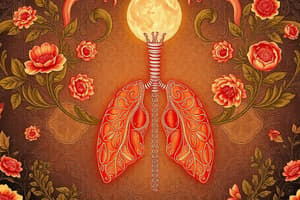Podcast
Questions and Answers
What does atmospheric air contain in higher levels?
What does atmospheric air contain in higher levels?
Nitrogen and oxygen
What does alveolar air contain more of compared to atmospheric air?
What does alveolar air contain more of compared to atmospheric air?
Carbon dioxide and water vapor
What does Dalton's Law state regarding total pressure?
What does Dalton's Law state regarding total pressure?
Total pressure equals the sum of partial pressures.
According to Henry's Law, what is gas solubility in a liquid proportional to?
According to Henry's Law, what is gas solubility in a liquid proportional to?
How is oxygen transported in the blood?
How is oxygen transported in the blood?
What is the definition of hypoxia?
What is the definition of hypoxia?
Which of the following are types of hypoxia?
Which of the following are types of hypoxia?
In what forms is carbon dioxide transported?
In what forms is carbon dioxide transported?
What is the main function of the ventral respiratory group?
What is the main function of the ventral respiratory group?
What does the dorsal respiratory group integrate for respiratory rhythm?
What does the dorsal respiratory group integrate for respiratory rhythm?
What is the role of the pons respiratory group in breathing?
What is the role of the pons respiratory group in breathing?
What does reciprocal inhibition prevent during respiration?
What does reciprocal inhibition prevent during respiration?
Which chemical factors influence breathing?
Which chemical factors influence breathing?
What does rising plasma $PCO_2$ stimulate?
What does rising plasma $PCO_2$ stimulate?
What does decreased pH cause in terms of breathing?
What does decreased pH cause in terms of breathing?
What do peripheral chemoreceptors detect?
What do peripheral chemoreceptors detect?
Define hyperventilation.
Define hyperventilation.
What does low $CO_2$ cause?
What does low $CO_2$ cause?
Define ischemia.
Define ischemia.
What causes dizziness from hyperventilation?
What causes dizziness from hyperventilation?
Why do swimmers hyperventilate before holding their breath?
Why do swimmers hyperventilate before holding their breath?
What must happen to $PCO_2$ levels after hyperventilation to trigger respiration?
What must happen to $PCO_2$ levels after hyperventilation to trigger respiration?
Which part of the brain regulates respiratory rate during strong emotions?
Which part of the brain regulates respiratory rate during strong emotions?
Which part of the brain controls ventilation behavior consciously?
Which part of the brain controls ventilation behavior consciously?
What are smelling salts?
What are smelling salts?
What is the active ingredient in smelling salts?
What is the active ingredient in smelling salts?
What effect does ammonia gas have on mucous membranes?
What effect does ammonia gas have on mucous membranes?
What is vigorous respiration?
What is vigorous respiration?
How do psychological stimuli affect respiration?
How do psychological stimuli affect respiration?
What is cortical motor stimulation?
What is cortical motor stimulation?
What do proprioceptors do during exercise?
What do proprioceptors do during exercise?
When does anaerobic respiration occur?
When does anaerobic respiration occur?
Define acute mountain sickness.
Define acute mountain sickness.
Define acclimatization.
Define acclimatization.
What hormone increases red blood cell production?
What hormone increases red blood cell production?
What do pulmonary function tests evaluate?
What do pulmonary function tests evaluate?
What characterizes obstructive disorders?
What characterizes obstructive disorders?
What condition results from obstructive pulmonary disorders?
What condition results from obstructive pulmonary disorders?
What is the definition of Total Lung Capacity (TLC)?
What is the definition of Total Lung Capacity (TLC)?
What is the definition of Vital Capacity (VC)?
What is the definition of Vital Capacity (VC)?
What is the definition of Inspiratory Reserve Volume (IRV)?
What is the definition of Inspiratory Reserve Volume (IRV)?
What is the definition of Residual Volume (RV)?
What is the definition of Residual Volume (RV)?
What causes limited lung expansion?
What causes limited lung expansion?
What is the definition of total lung capacity?
What is the definition of total lung capacity?
What is the definition of expiratory reserve volume?
What is the definition of expiratory reserve volume?
Flashcards
Atmospheric air
Atmospheric air
Contains higher nitrogen and oxygen concentrations.
Alveolar air
Alveolar air
Contains more carbon dioxide and water vapor.
Dalton's Law
Dalton's Law
Total pressure of a gas mixture is the sum of individual gas pressures.
Henry's Law
Henry's Law
Signup and view all the flashcards
Oxygen transport
Oxygen transport
Signup and view all the flashcards
Hypoxia
Hypoxia
Signup and view all the flashcards
Rising plasma PCO2
Rising plasma PCO2
Signup and view all the flashcards
Hyperventilation
Hyperventilation
Signup and view all the flashcards
Cerebral vasoconstriction
Cerebral vasoconstriction
Signup and view all the flashcards
Ischemia
Ischemia
Signup and view all the flashcards
Dizziness from Hyperventilation
Dizziness from Hyperventilation
Signup and view all the flashcards
Smelling Salts
Smelling Salts
Signup and view all the flashcards
Vigorous Respiration
Vigorous Respiration
Signup and view all the flashcards
Proprioceptors
Proprioceptors
Signup and view all the flashcards
Acute Mountain Sickness
Acute Mountain Sickness
Signup and view all the flashcards
Acclimatization
Acclimatization
Signup and view all the flashcards
Pulmonary Function Tests
Pulmonary Function Tests
Signup and view all the flashcards
Obstructive Disorders
Obstructive Disorders
Signup and view all the flashcards
Restrictive Disorders
Restrictive Disorders
Signup and view all the flashcards
Total Lung Capacity
Total Lung Capacity
Signup and view all the flashcards
Vital Capacity
Vital Capacity
Signup and view all the flashcards
Residual Volume (RV)
Residual Volume (RV)
Signup and view all the flashcards
Chronic Obstructive Pulmonary Diseases (COPD)
Chronic Obstructive Pulmonary Diseases (COPD)
Signup and view all the flashcards
Emphysema
Emphysema
Signup and view all the flashcards
Chronic bronchitis
Chronic bronchitis
Signup and view all the flashcards
Asthma
Asthma
Signup and view all the flashcards
Bronchospasms
Bronchospasms
Signup and view all the flashcards
Barrel chest
Barrel chest
Signup and view all the flashcards
Accessory muscles
Accessory muscles
Signup and view all the flashcards
Dyspnea
Dyspnea
Signup and view all the flashcards
Study Notes
- Atmospheric air has higher nitrogen and oxygen levels compared to alveolar air.
- Alveolar air contains more carbon dioxide and water vapor than atmospheric air.
- According to Dalton's Law, the total pressure exerted by a mixture of gases is equal to the sum of the partial pressures of each individual gas.
- Henry's Law states that the solubility of a gas in a liquid is proportional to the partial pressure of the gas above the liquid.
- Oxygen is primarily transported in the blood by binding to hemoglobin within red blood cells.
- Hypoxia refers to a deficiency of oxygen reaching the tissues of the body.
- Types of hypoxia include hypoxic, anemic, stagnant, and histotoxic hypoxia.
- Carbon dioxide is transported in the blood as bicarbonate ions, as dissolved gas, and in the form of carbamino compounds.
- The ventral respiratory group (VRG) in the brainstem serves as the primary rhythm-generating center for both inhalation and exhalation.
- The dorsal respiratory group (DRG) integrates sensory inputs to modulate respiratory rhythm.
- Pons respiratory group helps smooth out the transitions between inhalation and exhalation.
- Reciprocal inhibition prevents simultaneous contraction of inhalation and exhalation muscles.
- Chemical factors such as carbon dioxide, oxygen, and hydrogen ion levels in the blood influence breathing rate and depth.
- Rising plasma PCO2 stimulates the medulla oblongata chemoreceptors, which increases breathing rate.
- Decreased pH causes increased breathing to normalize blood pH.
- Peripheral chemoreceptors detect changes in arterial PO2 and pH.
- Hyperventilation is an increased breathing rate that exceeds the body's needs for carbon dioxide removal.
- Low CO2 causes cerebral vasoconstriction, reducing blood flow to the brain.
- Ischemia refers to an insufficient blood supply to tissues.
- Dizziness from hyperventilation is caused by low CO2 levels and subsequent cerebral ischemia.
- Swimmers sometimes use hyperventilation to extend the duration they can hold their breath.
- After hyperventilation, PCO2 levels must increase sufficiently to trigger respiration.
- The hypothalamus can regulate respiratory rate during strong emotions.
- The cerebral cortex allows for conscious control of ventilation behavior.
- Smelling salts contain volatile compounds that trigger an inhalation reflex.
- Ammonium carbonate is the active ingredient in smelling salts.
- Ammonia gas irritates mucous membranes, stimulating a sympathetic reflex.
- Vigorous respiration refers to deep, forceful breathing during intense exercise.
- Psychological stimuli, such as anticipation of exercise, can affect respiration.
- Cortical motor stimulation involves the simultaneous activation of muscles and respiratory centers.
- Proprioceptors are sensory receptors that provide information to respiratory areas during exercise.
- Anaerobic respiration occurs when oxygen supply is insufficient during intense exercise.
- Acute Mountain Sickness is an illness that can occur from rapid altitude change above 2.5 km.
- Acclimatization is the long-term adaptation to high altitude conditions.
- Erythropoietin is a hormone that increases red blood cell production.
- Pulmonary Function Tests evaluate respiratory function using a spirometer.
- Obstructive disorders are characterized by reduced airflow and increased residual volume.
- Restrictive disorders are characterized by reduced lung volumes and capacity.
- Hyperinflation is a lung condition resulting from obstructive pulmonary disorders.
Lung Capacity
- Total Lung Capacity (TLC) is the maximum amount of air the lungs can hold.
- Vital Capacity (VC) is the maximum amount of air that can be expelled after a maximum inhalation.
- Inspiratory Reserve Volume (IRV) is the extra air that can be inhaled after a normal inhalation.
- Expiratory Reserve Volume (ERV) is the extra air that can be exhaled after a normal exhalation.
- Residual Volume (RV) is the air remaining in the lungs after maximal exhalation.
- Restrictive pulmonary disorders limit lung expansion due to scar tissue.
Volume Measurements
- Vital capacity is the maximum amount of air exhaled after maximum inhalation.
- Total lung capacity is the total volume of air in the lungs after maximum inhalation.
- Residual volume is the air remaining in the lungs after forced exhalation.
- Expiratory reserve volume is the additional air exhaled after normal expiration.
COPD and Related Issues
- Chronic obstructive pulmonary diseases (COPD) are progressive lung diseases that cause airflow obstruction.
- Air hunger refers to the labored breathing sensation due to insufficient airflow.
- Emphysema is a type of COPD characterized by enlarged alveoli and deterioration of alveolar walls.
- Chronic bronchitis is a type of COPD characterized by excessive mucus production and airway inflammation.
- Alpha-1 antitrypsin deficiency is a genetic condition that increases the risk of emphysema.
- Neutrophil elastase is an enzyme that breaks down lung tissue elasticity.
- Asthma is an inflammatory airway disease that causes wheezing and coughing.
- Bronchospasms are contractions of airway muscles causing obstruction.
- Hyperinflation is excess air trapped in the lungs, which reduces their efficiency.
- Barrel chest is a change in chest shape due to lung hyperinflation.
- Accessory muscles are muscles used to aid breathing in respiratory distress.
- Pulmonary infections frequently affect the lungs when COPD is present.
- Environmental pollutants are substances in the environment that can harm one's health.
- Inflammatory exudate is fluid containing immune cells found in inflamed airways.
- Dyspnea is difficulty breathing or shortness of breath.
- Hyperpnea is a increased breathing rate due to metabolic demand.
- Acclimatization to high altitude involves physiological adjustments to lower oxygen availability.
Studying That Suits You
Use AI to generate personalized quizzes and flashcards to suit your learning preferences.




